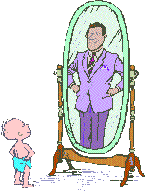A story was retold on David Maister's blog today which is very true and very relevant to many things I have been working on recently. It was told to him by Francis Sheridan.
"About ten years ago, while a manager for Washington State, I took a week's class from a person considered, at the time, maybe the most talented and accomplished person in Washington State government, Dick Thomas. He'd been Chief of Staff for the Governor, house majority leader, president of Evergreen State College, etc., and a very cool guy to boot. When I took that class, he said two things over and over.
Long after the class ended, I finally began to understand the wisdom of these two simple thoughts:
1. Policy is what happens.
2. Peoples' feelings about the process largely determine their feelings about the outcome of the process."
Sometimes we can fool ourselves into thinking that great policy is synonymous with a deliberate culture or that documented processes lead to good results. My experience echoes that above: good people doing good things leads to good results. If the results are measured and celebrated, the culture adjusts to reinforce the behaviors that lead to the good results. Sometimes by the time you have processes and policies documented, the business environment has changed and the good people on your staff have made the necessary adjustments. Then, the documentation, coordination, and training begins again. The official action of policies and processes follows the intention and the engagement. Not the other way around.
"About ten years ago, while a manager for Washington State, I took a week's class from a person considered, at the time, maybe the most talented and accomplished person in Washington State government, Dick Thomas. He'd been Chief of Staff for the Governor, house majority leader, president of Evergreen State College, etc., and a very cool guy to boot. When I took that class, he said two things over and over.
Long after the class ended, I finally began to understand the wisdom of these two simple thoughts:
1. Policy is what happens.
2. Peoples' feelings about the process largely determine their feelings about the outcome of the process."
Sometimes we can fool ourselves into thinking that great policy is synonymous with a deliberate culture or that documented processes lead to good results. My experience echoes that above: good people doing good things leads to good results. If the results are measured and celebrated, the culture adjusts to reinforce the behaviors that lead to the good results. Sometimes by the time you have processes and policies documented, the business environment has changed and the good people on your staff have made the necessary adjustments. Then, the documentation, coordination, and training begins again. The official action of policies and processes follows the intention and the engagement. Not the other way around.


 I ran across an ad for a beautiful product tonight and I couldn't resist playing with their interactive website.
I ran across an ad for a beautiful product tonight and I couldn't resist playing with their interactive website. 




